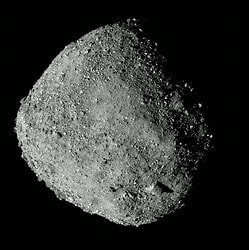Let’s have the bad news first! The cost of NASA’s OSIRIS-REx and OSIRIS-APEX missions is slightly north of a billion dollars.
You may ask why we have spent that money, and I will attempt to answer that question farther down the page. But first, allow me to applaud these scientific accomplishments.
OSIRIS-REx began with a launch in 2016. As you may know, the mission’s first objective was to rendezvous with and study an asteroid the size of the Empire State Building. The first stage of the operation was admirable on its own, because Bennu is orbiting the Sun at a speed of 63,000 miles per hour, and anywhere from 482,120 kilometers to 202.84 million kilometers from Earth.
Next NASA scientists engineered the craft to land a probe on the surface and retrieve a sample.
They also engineered the craft to retrieve the sample.
Even more astounding, the project engineering successfully sent the sample back to Earth. The sample landed last month at a very specific and planned location, the Department of Defense’s Utah Test and Training Range, 80 miles west of Salt Lake City.
The mission will now continue by flying to study an additional near-Earth asteroid, Apophis. This next part of the mission is called OSIRIS-APEX.
There are two reasons we have spent a billion dollars. One reason is theoretical and the other practical.
First the theoretical! The sample from Bennu contains both water and carbon. This is a huge cosmological finding which bolsters the prominent scientific speculation that the building blocks of life fell from the sky during the chaotic beginnings of the Universe.
Now the practical! These rocks are a potential danger to life as we know it. This mission proves that we can track these objects; and, if need be, do something about them.


In a libertarian world of much smaller government, private organizations would fund basic research. Collective defense would still be a government function.
Thanks for sharing your vision, Richard. If I hold my head at just the right angle, I see it too!